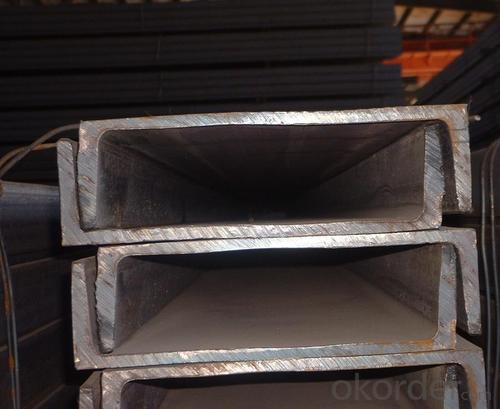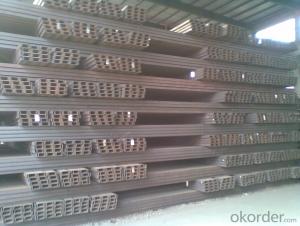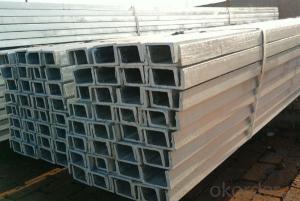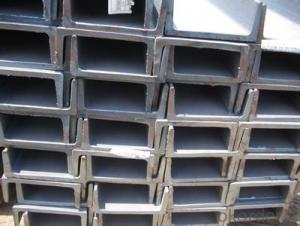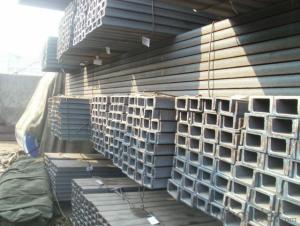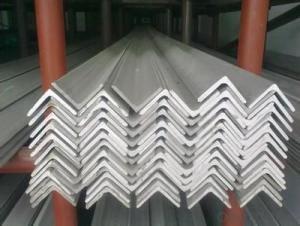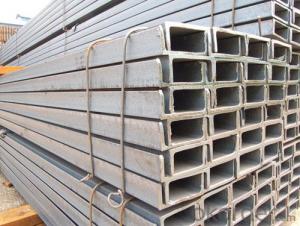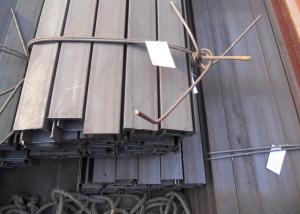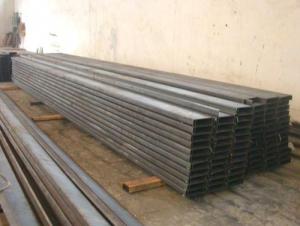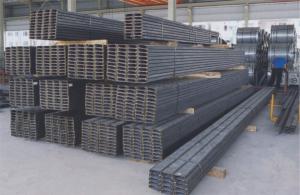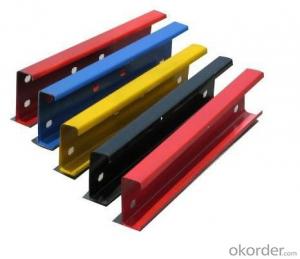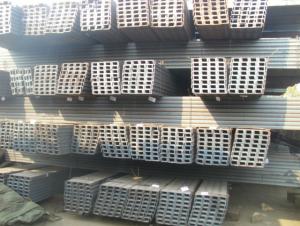High quality UPN ou JIS U CHANNEL ou GB U CHANNEL
- Loading Port:
- Tianjin
- Payment Terms:
- TT OR LC
- Min Order Qty:
- 25 m.t.
- Supply Capability:
- 20000000 m.t./month
OKorder Service Pledge
OKorder Financial Service
You Might Also Like
U CHANNEL Details:
Specifications of MS Channel:Product Description:
1.We supply high quality MS Channel at reasonable price, including Chinese standard, Japanese standard and so on.
Standard | GB/JIS |
Material Grade | Q235,SS400 |
Technique: | Hot Rolled |
Sizes as per chinese standard: | 50*37*4.5mm - 300*89*11.5mm |
Sizes as per japanese standard: | 50*25*3mm – 200*80*7.5mm |
Length: | 6meter, 9meter, 12meter |
Note: 1.we are also competent to provide our customers other MS Channel based on other sizes according to customer’s requirements.
2. The length of our ms channel could be cut into other meters as per customer’s requirements. For example, the channel in 6meters could be cut into 5.8meters in order to be fit in the 20ft container.
2. The detailed sections of MS Channel as per GB standard.are shown in the table-1:
GB U CHANNEL | Standard | Sectional | Dimension |
| Mass: |
(mm) | (mm) | (mm) | (mm) | ||
50X37 | 50 | 37 | 4.50 | 7.0 | 5.438 |
63X40 | 63 | 40 | 4.80 | 7.5 | 6.634 |
80x43 | 80 | 43 | 5.00 | 8.0 | 8.045 |
100x48 | 100 | 48 | 5.30 | 8.5 | 10.007 |
120x53 | 120 | 53 | 5.50 | 9.0 | 12.059 |
140x58 | 140 | 58 | 6.00 | 9.5 | 14.535 |
140x60 | 140 | 60 | 8.00 | 9.5 | 16.733 |
160x63 | 160 | 63 | 6.50 | 10.0 | 17.240 |
160x65 | 160 | 65 | 8.50 | 10.0 | 19.752 |
180x68 | 180 | 68 | 7.00 | 10.5 | 20.174 |
180x70 | 180 | 70 | 9.00 | 10.5 | 23.000 |
200x73 | 200 | 73 | 7.00 | 11.0 | 22.637 |
200x75 | 200 | 75 | 9.00 | 11.0 | 25.777 |
220x77 | 220 | 77 | 7.00 | 11.5 | 24.999 |
220x79 | 220 | 79 | 9.00 | 11.5 | 28.453 |
250x78 | 250 | 78 | 7.00 | 12.0 | 27.410 |
250x80 | 250 | 80 | 9.00 | 12.0 | 31.335 |
250x82 | 250 | 82 | 11.00 | 12.0 | 35.260 |
280x82 | 280 | 82 | 7.50 | 12.5 | 31.427 |
280x84 | 280 | 84 | 9.50 | 12.5 | 35.823 |
280x86 | 280 | 86 | 11.50 | 12.5 | 40.219 |
300x85 | 300 | 85 | 7.50 | 13.5 | 34.463 |
300x87 | 300 | 87 | 9.50 | 13.5 | 39.173 |
300x89 | 300 | 89 | 11.50 | 13.5 | 43.883 |
Table-1
3. The chemical composition of HR Channel Steel according to Q235B is shown in Table-2.
Alloy No | Grade | Element(%) | ||||
C | Mn | S | P | Si | ||
Q235 | B | 0.12-0.20 | 0.3-0.7 | ≦0.045 | ≦0.045 | ≦0.3 |
Table-2
Note: we are able to present our customers relevant SGS test report for chemical composition of HR Channel Steel.
4. The mechanical property of HR Channel Steel according to Q235B is shown in Table-3-1 and Table-3-2
Alloy No | Grade | Yielding Strength Point(Mpa) | |||
Thickness(mm) | |||||
≦16 | >16-40 | >40-60 | >60-100 | ||
≧ | |||||
Q235 | B | 235 | 225 | 215 | 205 |
Table-3-1
Alloy No | Grade | Tensile Strength(Mpa) | Elongation After Fracture(%) | |||
Thickness(mm) | ||||||
≦16 | >16-40 | >40-60 | >60-100 | |||
≧ | ||||||
G235 | B | 375-500 | 26 | 25 | 24 | 23 |
Table-3-2
Note: we are able to present our customers relevant SGS test report for mechanical property of MS Channel as customer’s request.
Applications of MS Channel:
The MS Channel can be applied to construction of warehouses, workshops, sport stadiums and car parks etc.The hot rolled channel steel belongs to carbon structural steel which is applied to in the field of construction and machinery.In details, the hot rolled channel steel is usually used for arch-itechtural structure, and they could be welded in order to support or hang a vari-ety of facilities. They are also usually used in combination with I beam. Generally,the hot rolled channel steel we supply must possess perfect welding property, riveting property and mechanical property and so on.
Package & Delivery of MS Channel:
1.The hot rolled channel steel will be packed in bundle with steel wire at each end of every bundle and color marking in order to help the customer to recognize his goods more easily at sight.
2. And the hot rolled channel steel could be loaded into 20ft or 40ft container, or by bulk cargo.If the weight of each bundle reaches more than 3.5 mt, the loading by break bulk cargo should be choosed.When the weight of each bundle reaches less than 3mt, the loading by container should be choosed.
3.As for the transportaion from mill to loading port, the truck will be usually used. And the maximum quantity for each truck is 40mt.
4.All in all, we could do in accordance with customer's request
Product Description:
Note: 1.we are also competent to provide our customers other MS Channel based on other sizes according to customer’s requirements.
2. The length of our ms channel could be cut into other meters as per customer’s requirements. For example, the channel in 6meters could be cut into 5.8meters in order to be fit in the 20ft container.
2. The detailed sections of MS Channel as per GB standard.are shown in the table-1:
GB U CHANNEL | Standard | Sectional | Dimension |
| Mass: |
(mm) | (mm) | (mm) | (mm) | ||
50X37 | 50 | 37 | 4.50 | 7.0 | 5.438 |
63X40 | 63 | 40 | 4.80 | 7.5 | 6.634 |
80x43 | 80 | 43 | 5.00 | 8.0 | 8.045 |
100x48 | 100 | 48 | 5.30 | 8.5 | 10.007 |
120x53 | 120 | 53 | 5.50 | 9.0 | 12.059 |
140x58 | 140 | 58 | 6.00 | 9.5 | 14.535 |
140x60 | 140 | 60 | 8.00 | 9.5 | 16.733 |
160x63 | 160 | 63 | 6.50 | 10.0 | 17.240 |
160x65 | 160 | 65 | 8.50 | 10.0 | 19.752 |
180x68 | 180 | 68 | 7.00 | 10.5 | 20.174 |
180x70 | 180 | 70 | 9.00 | 10.5 | 23.000 |
200x73 | 200 | 73 | 7.00 | 11.0 | 22.637 |
200x75 | 200 | 75 | 9.00 | 11.0 | 25.777 |
220x77 | 220 | 77 | 7.00 | 11.5 | 24.999 |
220x79 | 220 | 79 | 9.00 | 11.5 | 28.453 |
250x78 | 250 | 78 | 7.00 | 12.0 | 27.410 |
250x80 | 250 | 80 | 9.00 | 12.0 | 31.335 |
250x82 | 250 | 82 | 11.00 | 12.0 | 35.260 |
280x82 | 280 | 82 | 7.50 | 12.5 | 31.427 |
280x84 | 280 | 84 | 9.50 | 12.5 | 35.823 |
280x86 | 280 | 86 | 11.50 | 12.5 | 40.219 |
300x85 | 300 | 85 | 7.50 | 13.5 | 34.463 |
300x87 | 300 | 87 | 9.50 | 13.5 | 39.173 |
300x89 | 300 | 89 | 11.50 | 13.5 | 43.883 |
Table-1
3. The chemical composition of HR Channel Steel according to Q235B is shown in Table-2.
Alloy No | Grade | Element(%) | ||||
C | Mn | S | P | Si | ||
Q235 | B | 0.12-0.20 | 0.3-0.7 | ≦0.045 | ≦0.045 | ≦0.3 |
Table-2
Note: we are able to present our customers relevant SGS test report for chemical composition of HR Channel Steel.
4. The mechanical property of HR Channel Steel according to Q235B is shown in Table-3-1 and Table-3-2
Alloy No | Grade | Yielding Strength Point(Mpa) | |||
Thickness(mm) | |||||
≦16 | >16-40 | >40-60 | >60-100 | ||
≧ | |||||
Q235 | B | 235 | 225 | 215 | 205 |
Table-3-1
Alloy No | Grade | Tensile Strength(Mpa) | Elongation After Fracture(%) | |||
Thickness(mm) | ||||||
≦16 | >16-40 | >40-60 | >60-100 | |||
≧ | ||||||
G235 | B | 375-500 | 26 | 25 | 24 | 23 |
Table-3-2
Note: we are able to present our customers relevant SGS test report for mechanical property of MS Channel as customer’s request.
Applications of MS Channel:
The MS Channel can be applied to construction of warehouses, workshops, sport stadiums and car parks etc.The hot rolled channel steel belongs to carbon structural steel which is applied to in the field of construction and machinery.In details, the hot rolled channel steel is usually used for arch-itechtural structure, and they could be welded in order to support or hang a vari-ety of facilities. They are also usually used in combination with I beam. Generally,the hot rolled channel steel we supply must possess perfect welding property, riveting property and mechanical property and so on.
Package & Delivery of MS Channel:
1.The hot rolled channel steel will be packed in bundle with steel wire at each end of every bundle and color marking in order to help the customer to recognize his goods more easily at sight.
2. And the hot rolled channel steel could be loaded into 20ft or 40ft container, or by bulk cargo.If the weight of each bundle reaches more than 3.5 mt, the loading by break bulk cargo should be choosed.When the weight of each bundle reaches less than 3mt, the loading by container should be choosed.
3.As for the transportaion from mill to loading port, the truck will be usually used. And the maximum quantity for each truck is 40mt.
4.All in all, we could do in accordance with customer's request


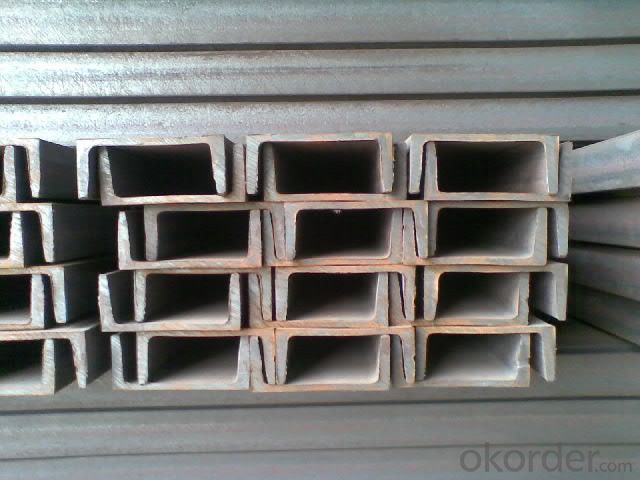
- Q: What are the different welding methods for steel channels?
- There are several different welding methods that can be used for steel channels, depending on the specific application and desired results. Some of the most common welding methods for steel channels include: 1. Shielded Metal Arc Welding (SMAW): Also known as stick welding, SMAW involves using an electrode coated in flux to create an arc between the electrode and the base metal. This method is versatile and can be used for both thick and thin steel channels, making it suitable for a wide range of applications. 2. Gas Metal Arc Welding (GMAW): Commonly referred to as MIG welding, GMAW uses a continuous wire electrode that is fed through a welding gun. The wire is melted and joined with the base metal while being shielded by a gas, typically a mixture of argon and carbon dioxide. This method is known for its speed and efficiency, making it ideal for high-volume production of steel channels. 3. Flux-Cored Arc Welding (FCAW): Similar to GMAW, FCAW utilizes a continuous wire electrode, but instead of using a shielding gas, it uses a flux-filled tubular wire. This flux creates a protective shield around the weld, eliminating the need for an external gas supply. FCAW is commonly used for outdoor applications or in environments with strong drafts that could blow away the shielding gas. 4. Gas Tungsten Arc Welding (GTAW): Also known as TIG welding, GTAW uses a non-consumable tungsten electrode to create an arc and heat the base metal. A separate filler rod is then manually fed into the weld pool, creating the joint. GTAW is known for its precision and control, making it suitable for welding thin steel channels or when a high-quality weld is required. 5. Submerged Arc Welding (SAW): SAW involves feeding a continuous wire electrode into the joint while a layer of granular flux covers the weld zone. The arc is submerged beneath the flux, providing a protective atmosphere and preventing the weld from being exposed to the surrounding air. This method is commonly used for thicker steel channels or when high deposition rates are required. It is important to consider the specific requirements of the steel channel and the intended application when selecting a welding method. Each method has its advantages and limitations, so it is crucial to choose the most appropriate method for achieving the desired results in terms of strength, aesthetics, and efficiency.
- Q: Two floors of shops, exterior wall hanging marble, I would like to ask the general keel, channel, angle steel with what kind of specifications? Is the angle iron L30*3 channel 6.3 OK? Do keel labour contractor, how much is the market price? The older generation with the experience helped! Thank you
- To see more large stonesCommonly used are 8# channel steel and 4# angle steel,You might be a little small,The key is to look at the specifications and weight of the stone.
- Q: What are the standard dimensions of steel channels?
- The standard dimensions of steel channels can vary depending on the specific type and design of the channel. However, in general, steel channels are typically measured by their height, width, and thickness. Common standard dimensions for steel channels range from 1 inch to 8 inches in height, 0.5 inch to 3 inches in width, and 0.125 inch to 0.5 inch in thickness. These dimensions are often specified in inches or millimeters. It is important to note that steel channels can also be customized to meet specific project requirements. In such cases, the dimensions may vary from the standard sizes mentioned above. Additionally, different countries or regions may have their own specific standards for steel channel dimensions. When working with steel channels, it is crucial to consult the applicable industry standards, regulations, and specifications to ensure the correct dimensions are used for a particular application.
- Q: Are steel channels suitable for high-rise buildings?
- Yes, steel channels are suitable for high-rise buildings. Steel channels provide excellent structural support and are commonly used in the construction of high-rise buildings due to their strength, durability, and ability to withstand heavy loads. They also offer flexibility in design and can be easily fabricated to meet the specific requirements of the building, making them a popular choice in high-rise construction projects.
- Q: How do steel channels perform in terms of acoustic insulation?
- Steel channels typically do not perform well in terms of acoustic insulation. Due to their rigid and dense nature, steel channels tend to transmit sound vibrations rather than absorb or dampen them. For effective acoustic insulation, alternative materials with better soundproofing properties such as acoustic foam or insulation panels are often recommended.
- Q: Are steel channels available in different colors?
- Typically, steel channels do not come in various colors. They are predominantly manufactured from carbon steel or stainless steel, both of which possess an inherent metallic look. Nevertheless, if desired, steel channels can be painted or coated in different hues. This can be achieved through techniques like powder coating or liquid paint coatings. Applying a layer of paint or coating enables customization to meet specific color preferences or to enhance protection against corrosion.
- Q: How to connect channel steel and round steel?
- End face of channel steel and end face of round steel:Can first welding a large circular steel plate and steel bar etc. in the channel to the end faces of the circular plate thickness should be more than 10mm, then the circular plate side angle steel and round steel bar to coincide welding, chamfering, need full welding between the two.
- Q: How do steel channels contribute to building security?
- Steel channels contribute to building security by providing structural support and reinforcement. They are commonly used in the construction of walls, floors, and roofs to enhance the overall strength and stability of the building. Steel channels help distribute the weight and loads evenly, making the structure more resistant to external forces such as strong winds, earthquakes, or impact. Additionally, they can be integrated with security systems to serve as barriers, preventing unauthorized access and enhancing the physical security of the building.
- Q: Are steel channels suitable for the power generation manufacturing industry?
- Certainly, the power generation manufacturing industry finds steel channels to be highly appropriate. Steel channels are extensively employed in the production of power generation equipment, encompassing turbines, generators, and transformers. The remarkable strength and durability of steel render it an exceptional material for bearing substantial loads and enduring the frequently encountered high temperatures and pressures in power generation procedures. Moreover, steel channels can be conveniently fabricated and tailored to meet the precise design specifications of power generation equipment. They offer stability, structural soundness, and dependability, thereby positioning themselves as a fitting selection for the power generation manufacturing industry.
- Q: What are the different methods of insulation for steel channels?
- Steel channels can be insulated using various methods, each with its own advantages and applications. Some commonly used methods are: 1. Thermal insulation: By using materials with low thermal conductivity, heat transfer can be reduced. Examples of thermal insulation materials for steel channels include mineral wool, fiberglass, foam insulation, and reflective barriers. These materials effectively prevent heat loss or gain, ensuring energy efficiency and maintaining a comfortable temperature within the channel. 2. Spray foam insulation: This technique involves applying a liquid foam insulation material onto the steel channel's surface. The foam rapidly expands and solidifies, creating a seamless and airtight insulation layer. Spray foam insulation offers excellent thermal and moisture resistance, as well as soundproofing properties. It adheres well to irregular shapes, easily fills gaps and cracks, and is a versatile insulation method. 3. Insulated panels: Insulated panels are pre-fabricated panels with an insulating core sandwiched between two metal skins. These panels can be directly attached to steel channels, providing an instant and efficient insulation solution. Insulated panels offer excellent thermal performance, noise reduction, and fire resistance. They are lightweight, easy to install, and commonly used in commercial and industrial applications. 4. Insulation wraps: Insulation wraps are flexible materials that can be wrapped around steel channels to provide insulation. These wraps are typically made of fiberglass or mineral wool and come in various thicknesses and widths. Insulation wraps provide thermal and acoustic insulation, as well as protection against corrosion and condensation. They are easy to install and can be customized to fit different channel sizes and shapes. 5. Reflective insulation: Reflective insulation utilizes materials such as aluminum foil to reflect radiant heat away from the steel channel. This method is particularly effective in hot climates as it helps reduce heat gain. Reflective insulation can be installed as sheets, rolls, or panels and is often combined with other insulation methods to enhance overall thermal efficiency. 6. Ceramic insulation coatings: Ceramic insulation coatings are applied directly onto the steel channel's surface. These coatings consist of ceramic particles suspended in a binder, creating a heat-resistant barrier. Ceramic insulation coatings provide excellent thermal insulation and can withstand high temperatures. They are commonly used in industrial settings that require extreme heat or fire protection. Choosing the appropriate insulation method for steel channels depends on factors like desired thermal performance, budget, installation requirements, and specific application. It is important to consider the unique properties and benefits of each method to select the most suitable insulation solution.
Send your message to us
High quality UPN ou JIS U CHANNEL ou GB U CHANNEL
- Loading Port:
- Tianjin
- Payment Terms:
- TT OR LC
- Min Order Qty:
- 25 m.t.
- Supply Capability:
- 20000000 m.t./month
OKorder Service Pledge
OKorder Financial Service
Similar products
Hot products
Hot Searches
Related keywords



